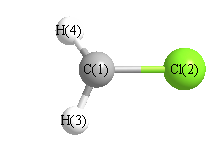Jump to
S1C2
Energy calculated at CCSD=FULL/6-31G*
| | hartrees |
|---|
| Energy at 0K | -498.739804 |
| Energy at 298.15K | |
| HF Energy | -498.460672 |
| Nuclear repulsion energy | 45.235093 |
The energy at 298.15K was derived from the energy at 0K
and an integrated heat capacity that used the calculated vibrational frequencies.
Vibrational Frequencies calculated at CCSD=FULL/6-31G*
| Mode Number |
Symmetry |
Frequency
(cm-1) |
Scaled Frequency
(cm-1) |
IR Intensities
(km mol-1) |
Raman Act
(Å4/u) |
Dep P |
Dep U |
|---|
| 1 |
A' |
3224 |
3062 |
7.49 |
|
|
|
| 2 |
A' |
1471 |
1397 |
14.26 |
|
|
|
| 3 |
A' |
869 |
826 |
32.68 |
|
|
|
| 4 |
A' |
206 |
196 |
80.03 |
|
|
|
| 5 |
A" |
3368 |
3199 |
0.53 |
|
|
|
| 6 |
A" |
1037 |
985 |
0.13 |
|
|
|
Unscaled Zero Point Vibrational Energy (zpe) 5087.6 cm
-1
Scaled (by 0.9498) Zero Point Vibrational Energy (zpe) 4832.2 cm
-1
See section
III.C.1 List or set vibrational scaling factors
to change the scale factors used here.
See section
III.C.2
Calculate a vibrational scaling factor for a given set of molecules
to determine the least squares best scaling factor.
Geometric Data calculated at CCSD=FULL/6-31G*
Point Group is Cs
Cartesians (Å)
| Atom |
x (Å) |
y (Å) |
z (Å) |
|---|
| C1 |
-0.007 |
1.121 |
0.000 |
| Cl2 |
-0.007 |
-0.587 |
0.000 |
| H3 |
0.082 |
1.625 |
0.952 |
| H4 |
0.082 |
1.625 |
-0.952 |
Atom - Atom Distances (Å)
| |
C1 |
Cl2 |
H3 |
H4 |
| C1 | | 1.7072 | 1.0811 | 1.0811 |
Cl2 | 1.7072 | | 2.4092 | 2.4092 | H3 | 1.0811 | 2.4092 | | 1.9047 | H4 | 1.0811 | 2.4092 | 1.9047 | |
 More geometry information
More geometry information
Calculated Bond Angles
| atom1 |
atom2 |
atom3 |
angle |
|
atom1 |
atom2 |
atom3 |
angle |
| Br2 |
C1 |
H3 |
117.785 |
|
Br2 |
C1 |
H4 |
117.785 |
| H3 |
C1 |
H4 |
123.496 |
|
Electronic energy levels
Charges, Dipole, Quadrupole and Polarizability
Jump to
S1C1
Energy calculated at CCSD=FULL/6-31G*
| | hartrees |
|---|
| Energy at 0K | -498.739795 |
| Energy at 298.15K | |
| HF Energy | -498.460569 |
| Nuclear repulsion energy | 45.255077 |
The energy at 298.15K was derived from the energy at 0K
and an integrated heat capacity that used the calculated vibrational frequencies.
Vibrational Frequencies calculated at CCSD=FULL/6-31G*
| Mode Number |
Symmetry |
Frequency
(cm-1) |
Scaled Frequency
(cm-1) |
IR Intensities
(km mol-1) |
Raman Act
(Å4/u) |
Dep P |
Dep U |
|---|
| 1 |
A1 |
3227 |
3065 |
6.85 |
|
|
|
| 2 |
A1 |
1471 |
1397 |
14.44 |
|
|
|
| 3 |
A1 |
871 |
828 |
31.95 |
|
|
|
| 4 |
B1 |
145i |
138i |
85.78 |
|
|
|
| 5 |
B2 |
3372 |
3203 |
0.38 |
|
|
|
| 6 |
B2 |
1034 |
982 |
0.15 |
|
|
|
Unscaled Zero Point Vibrational Energy (zpe) 4915.2 cm
-1
Scaled (by 0.9498) Zero Point Vibrational Energy (zpe) 4668.5 cm
-1
See section
III.C.1 List or set vibrational scaling factors
to change the scale factors used here.
See section
III.C.2
Calculate a vibrational scaling factor for a given set of molecules
to determine the least squares best scaling factor.
Geometric Data calculated at CCSD=FULL/6-31G*
Point Group is C2v
Cartesians (Å)
| Atom |
x (Å) |
y (Å) |
z (Å) |
|---|
| C1 |
0.000 |
0.000 |
-1.119 |
| Cl2 |
0.000 |
0.000 |
0.587 |
| H3 |
0.000 |
0.954 |
-1.628 |
| H4 |
0.000 |
-0.954 |
-1.628 |
Atom - Atom Distances (Å)
| |
C1 |
Cl2 |
H3 |
H4 |
| C1 | | 1.7059 | 1.0808 | 1.0808 |
Cl2 | 1.7059 | | 2.4113 | 2.4113 | H3 | 1.0808 | 2.4113 | | 1.9071 | H4 | 1.0808 | 2.4113 | 1.9071 | |
 More geometry information
More geometry information
Calculated Bond Angles
| atom1 |
atom2 |
atom3 |
angle |
|
atom1 |
atom2 |
atom3 |
angle |
| Br2 |
C1 |
H3 |
118.090 |
|
Br2 |
C1 |
H4 |
118.090 |
| H3 |
C1 |
H4 |
123.821 |
|
Electronic energy levels
Charges, Dipole, Quadrupole and Polarizability
